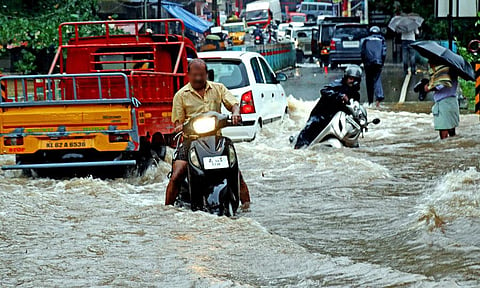

THIRUVANANTHAPURAM: The main rainy season in Kerala is the southwest monsoon, which usually begins close to June 1 and ends by September 30 when the rain intensity subsides considerably.
The withdrawal of the southwest monsoon also heralds the advent of north-easterly winds bringing in the northeast monsoon to parts of peninsular Andhra Pradesh and Tamil Nadu. But there would be a gap of around two weeks between the two monsoon seasons. This time, the India Meteorological Department is yet to announce the formal withdrawal of the southwest monsoon from Kerala.
Similarly, the pre-monsoon season of mainly April-May and the post-monsoon season of September-December witnesses two to three tropical cyclones over the Arabian Sea every calendar year, an average of one storm in the pre-monsoon period, and one to two storms in the post-monsoon period due to the warm surface temperature in the Arabian Sea.
However, the weather pattern has been changing fast over the last few years. The sea surface temperature in the Arabian Sea is generally 1.5%-2% lower than in the Bay of Bengal. This is one of the main reasons for the fewer cyclonic circulations over the Arabian Sea.
A study by scientists of the Indian Institute of Tropical Meteorology (IITM) under the Union ministry of earth sciences has found a 52% increase in the frequency of cyclones over the Arabian Sea between 2001 and 2019, while there was an 8% decrease of the same over the Bay of Bengal, as compared to the 19-year period between 1982 and 2002.
In 2018 when Kerala witnessed the megaflood, the Indian Ocean witnessed seven cyclones of which three were from the Arabian Sea. In 2019 when the state witnessed the second back-to-back flood, the Arabian Sea contributed five cyclones of the total eight cyclones in the north Indian Ocean.
The IMD stats also show nine cyclones and depressions had formed in 2020, of which four were over the Arabian Sea. The number was seven in 2019. During the 1960-70 period, the Bay of Bengal witnessed 135 cyclonic storms and depressions while the number was 23 over the Arabian Sea. In the 2010-20 period, the number of cyclones and depressions over the Bay of Bengal nosedived to 59, while it increased to 33 over the Arabian Sea.
These figures give enough hints for Kerala to take long-term mitigating actions rather than knee-jerk reactions in every monsoon period. The climate change over the Arabian Sea is having a direct bearing on the rain pattern in Kerala which is evident from the rainfall that the state has received in the last four years. Though July and June are the months that brought copious rain to Kerala in the past, spells of very heavy rain in a short span of time have been seen in August and September in the last four years.
The water management system of Kerala has to be improved. Besides, forecasting of rain, especially extreme rainfall events, although there are certain limitations for providing accurate forecast, has to be improved. Kerala has to also follow a development model taking note of the change in the monsoon behaviour, he said.
Madhavan Rajeevan, former secretary Ministry of Earth Science, told TNIE, “There has been a clear shift in the rain pattern in Kerala in the last few years and extreme rainfall events have become a norm of the season in the state which always leads to flash floods. The frequency of cyclonic circulations over the Arabian Sea has increased contributing to the change in the distribution of rain over Kerala, although there was no big difference in the annual total rainfall of the state,” he said.
“The state will have to give more priority to environment impact assessment when it takes up development projects as cloudbursts and extreme rainfall events leading to flash floods would become normal in the future. The state will have to pay a heavy price if it goes ahead with projects without taking note of the climate change,” said Dr M G Manoj, a research scientist with Advanced Centre for Atmospheric Radar Research, Cochin University of Science and Technology.
“The convective clouds have started climbing to a height of 15-16km over Kerala at times with the top temperature of clouds attaining minus 62-82 degree Celsius range which means cloudburst has become a part of the monsoon season in Kerala,” he added.
There is no point in thinking that the number of low pressure formations and cyclonic storms over the Arabian Sea will come down in the near future. In fact, a number of studies have pointed out that this phenomenon would increase because of global warming.
“In short, we should be prepared to face monsoon calamities by drawing lessons from other parts of the world and following a system reducing the impact of calamities in such a scenario would be ideal for the state,” said Dr Pratheesh C Mammen, climate researcher.